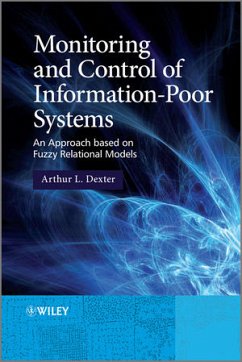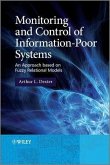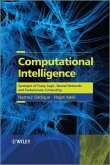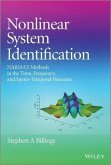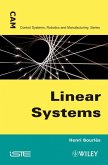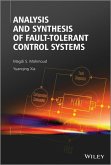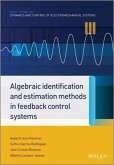Monitoring and Control of Information-Poor Systems (eBook, ePUB)
An Approach based on Fuzzy Relational Models


Alle Infos zum eBook verschenken

Monitoring and Control of Information-Poor Systems (eBook, ePUB)
An Approach based on Fuzzy Relational Models
- Format: ePub
- Merkliste
- Auf die Merkliste
- Bewerten Bewerten
- Teilen
- Produkt teilen
- Produkterinnerung
- Produkterinnerung

Hier können Sie sich einloggen

Bitte loggen Sie sich zunächst in Ihr Kundenkonto ein oder registrieren Sie sich bei bücher.de, um das eBook-Abo tolino select nutzen zu können.
The monitoring and control of a system whose behaviour is highly uncertain is an important and challenging practical problem. Methods of solution based on fuzzy techniques have generated considerable interest, but very little of the existing literature considers explicit ways of taking uncertainties into account. This book describes an approach to the monitoring and control of information-poor systems that is based on fuzzy relational models which generate fuzzy outputs. The first part of Monitoring and Control of Information-Poor Systems aims to clarify why design decisions must take account…mehr
- Geräte: eReader
- mit Kopierschutz
- eBook Hilfe
- Größe: 8.83MB
![Monitoring and Control of Information-Poor Systems (eBook, PDF) Monitoring and Control of Information-Poor Systems (eBook, PDF)]() Arthur L. DexterMonitoring and Control of Information-Poor Systems (eBook, PDF)110,99 €
Arthur L. DexterMonitoring and Control of Information-Poor Systems (eBook, PDF)110,99 €![Computational Intelligence (eBook, ePUB) Computational Intelligence (eBook, ePUB)]() Nazmul SiddiqueComputational Intelligence (eBook, ePUB)110,99 €
Nazmul SiddiqueComputational Intelligence (eBook, ePUB)110,99 €![Nonlinear System Identification (eBook, ePUB) Nonlinear System Identification (eBook, ePUB)]() Stephen A. BillingsNonlinear System Identification (eBook, ePUB)117,99 €
Stephen A. BillingsNonlinear System Identification (eBook, ePUB)117,99 €![Linear Systems (eBook, ePUB) Linear Systems (eBook, ePUB)]() Henri BourlèsLinear Systems (eBook, ePUB)160,99 €
Henri BourlèsLinear Systems (eBook, ePUB)160,99 €![Analysis and Synthesis of Fault-Tolerant Control Systems (eBook, ePUB) Analysis and Synthesis of Fault-Tolerant Control Systems (eBook, ePUB)]() Magdi S. MahmoudAnalysis and Synthesis of Fault-Tolerant Control Systems (eBook, ePUB)110,99 €
Magdi S. MahmoudAnalysis and Synthesis of Fault-Tolerant Control Systems (eBook, ePUB)110,99 €![Algebraic Identification and Estimation Methods in Feedback Control Systems (eBook, ePUB) Algebraic Identification and Estimation Methods in Feedback Control Systems (eBook, ePUB)]() Hebertt Sira-RamírezAlgebraic Identification and Estimation Methods in Feedback Control Systems (eBook, ePUB)110,99 €
Hebertt Sira-RamírezAlgebraic Identification and Estimation Methods in Feedback Control Systems (eBook, ePUB)110,99 €![Sliding Mode Control of Uncertain Parameter-Switching Hybrid Systems (eBook, ePUB) Sliding Mode Control of Uncertain Parameter-Switching Hybrid Systems (eBook, ePUB)]() Ligang WuSliding Mode Control of Uncertain Parameter-Switching Hybrid Systems (eBook, ePUB)110,99 €
Ligang WuSliding Mode Control of Uncertain Parameter-Switching Hybrid Systems (eBook, ePUB)110,99 €-
-
-
Dieser Download kann aus rechtlichen Gründen nur mit Rechnungsadresse in A, B, BG, CY, CZ, D, DK, EW, E, FIN, F, GR, HR, H, IRL, I, LT, L, LR, M, NL, PL, P, R, S, SLO, SK ausgeliefert werden.
Hinweis: Dieser Artikel kann nur an eine deutsche Lieferadresse ausgeliefert werden.
- Produktdetails
- Verlag: Wiley
- Seitenzahl: 352
- Erscheinungstermin: 16. Februar 2012
- Englisch
- ISBN-13: 9781119940289
- Artikelnr.: 37355965
- Verlag: Wiley
- Seitenzahl: 352
- Erscheinungstermin: 16. Februar 2012
- Englisch
- ISBN-13: 9781119940289
- Artikelnr.: 37355965
- Herstellerkennzeichnung Die Herstellerinformationen sind derzeit nicht verfügbar.
About the Author xv
Acknowledgements xvii
I ANALYSING THE BEHAVIOUR OF INFORMATION-POOR SYSTEMS
1 Characteristics of Information-Poor Systems 3
1.1 Introduction to Information-Poor Systems 3
1.1.1 Blast Furnaces 3
1.1.2 Container Cranes 3
1.1.3 Cooperative Control Systems 4
1.1.4 Distillation Columns 4
1.1.5 Drug Administration 4
1.1.6 Electrical Power Generation and Distribution 4
1.1.7 Environmental Risk Assessment Systems 4
1.1.8 Financial Investment and Portfolio Selection 5
1.1.9 Health Care Systems 5
1.1.10 Indoor Climate Control 5
1.1.11 NOx Emissions from Gas Turbines and Internal Combustion Engines 6
1.1.12 Penicillin Production Plant 6
1.1.13 Polymerization Reactors 6
1.1.14 Rotary Kilns 6
1.1.15 Solar Power Plant 7
1.1.16 Wastewater Treatment Plant 7
1.1.17 Wood Pulp Production Plant 7
1.2 Main Causes of Uncertainty 7
1.2.1 Sources of Modelling Errors 8
1.2.2 Sources of Measurement Errors 8
1.2.3 Reasons for Poorly Defined Objectives and Constraints 9
1.3 Design in the Face of Uncertainty 9
References 9
2 Describing and Propagating Uncertainty 13
2.1 Methods of Describing Uncertainty 13
2.1.1 Uncertainty Intervals and Probability Distributions 13
2.1.2 Fuzzy Sets and Fuzzy Numbers 14
2.2 Methods of Propagating Uncertainty 15
2.2.1 Interval Arithmetic 15
2.2.2 Statistical Methods 16
2.2.3 Monte Carlo Methods 16
2.2.4 Fuzzy Arithmetic 17
2.3 Fuzzy Arithmetic Using ¿-Cut Sets and Interval Arithmetic 18
2.4 Fuzzy Arithmetic Based on the Extension Principle 21
2.5 Representing and Propagating Uncertainty Using Pseudo-Triangular
Membership Functions 24
2.6 Summary 27
References 27
3 Accounting for Measurement Uncertainty 29
3.1 Measurement Errors 29
3.2 Introduction to Fuzzy Random Variables 29
3.2.1 Definition of a Fuzzy Random Variable 30
3.2.2 Generating Fuzzy Random Variables from a Knowledge of the Random and
Systematic Errors 30
3.3 A Hybrid Approach to the Propagation of Uncertainty 32
3.4 Fuzzy Sensor Fusion Based on the Extension Principle 34
3.5 Fuzzy Sensors 38
3.6 Summary 39
References 39
4 Accounting for Modelling Errors in Fuzzy Models 41
4.1 An Introduction to Rule-Based Models 41
4.2 Linguistic Fuzzy Models 41
4.2.1 Fuzzy Rules 41
4.2.2 Fuzzy Inferencing 42
4.2.3 Compositional Rules of Inference 43
4.3 Functional Fuzzy Models 47
4.4 Fuzzy Neural Networks 48
4.5 Methods of Generating Fuzzy Models 50
4.5.1 Modifying Expert Rules to Take Account of Uncertainty 50
4.5.2 Identifying Fuzzy Rules from Data 56
4.6 Defuzzification 58
4.7 Summary 60
References 60
5 Fuzzy Relational Models 63
5.1 Introduction to Fuzzy Relations and Fuzzy Relational Models 63
5.2 Fuzzy FRMs 65
5.3 Methods of Estimating Rule Confidences from Data 67
5.4 Estimating Probability Density Functions from Data 70
5.4.1 Probabilistic Interpretation of RSK Fuzzy Identification 71
5.4.2 Effect of Structural Errors on the Output of a Fuzzy FRM 78
5.4.3 Estimation Based on Limited Amounts of Training Data 83
5.5 Generic Fuzzy Models 86
5.5.1 Identification of Generic Fuzzy Models 87
5.5.2 Reducing the Time Required to Generate the Training Data 91
5.6 Summary 92
References 92
II CONTROL OF INFORMATION-POOR SYSTEMS
6 Fuzzy Decision-Making 97
6.1 Risk Assessment in Information-Poor Systems 97
6.2 Fuzzy Optimization in Information-Poor Systems 99
6.2.1 Fuzzy Goals and Fuzzy Constraints 99
6.2.2 Fuzzy Aggregation Operators 99
6.2.3 Fuzzy Ranking 100
6.3 Multi-Stage Decision-Making 101
6.3.1 Fuzzy Dynamic Programming 102
6.3.2 Branch and Bound 103
6.3.3 Genetic Algorithms 106
6.4 Fuzzy Decision-Making Based on Intuitionistic Fuzzy Sets 106
6.4.1 Definition of an Intuitionistic Fuzzy Set 106
6.4.2 Multi-Attribute Decision-Making Using Intuitionistic Fuzzy Numbers
107
6.5 Summary 108
References 108
7 Predictive Control in Uncertain Systems 111
7.1 Model-Based Predictive Control 111
7.2 Fuzzy Approaches to Model-Based Control of Uncertain Systems 112
7.2.1 Inverse Control of Fuzzy Interval Systems 112
7.2.2 Fuzzy Model-Based Predictive Control 114
7.3 Practical Issues Associated with Multi-Step Fuzzy Decision-Making 115
7.3.1 Limiting the Accumulation of Uncertainty 115
7.3.2 Avoiding Excessive Computational Demands When Using Enumerative
Search Optimization 115
7.3.3 Avoiding Excessive Computational Demands When Using Evolutionary
Algorithms 116
7.3.4 Handling Infeasibility 117
7.3.5 Choosing the Weighting in Multi-Criteria Cost Functions 117
7.3.6 Dealing with Hard Constraints 118
7.4 A Simplified Approach to Fuzzy FRM-Based Predictive Control 118
7.4.1 The Fuzzy Decision-Maker 119
7.4.2 Conditional Defuzzification 120
7.5 FMPC of an Uncertain Dynamic System Based on a Generic Fuzzy FRM 122
7.6 Summary 127
References 128
8 Incorporating Fuzzy Inputs 129
8.1 Fuzzy Setpoints and Fuzzy Measurements 129
8.1.1 Fuzzy Setpoints 129
8.1.2 Fuzzy Measurements 129
8.2 Fuzzy Measures of the Tracking Error and its Derivative 131
8.3 Inference with Fuzzy Inputs 136
8.4 Fuzzy Output Neural Networks 138
8.5 Modelling Input Uncertainty Using a Fuzzy FRM 140
8.6 Summary 151
References 151
9 Disturbance Rejection in Information-Poor Systems 153
9.1 Rejecting Unmeasured Disturbances in Uncertain Systems 154
9.1.1 Robust Fuzzy Control 154
9.1.2 Feedback Linearization Using a Fuzzy Disturbance Observer 155
9.1.3 Fuzzy Model-Based Internal Model Control 155
9.2 Fuzzy IMC Based on a Fuzzy Output FRM 157
9.3 Rejecting Measured Disturbances in Non-Linear Uncertain Systems 161
9.4 Fuzzy MPC with Feedforward 162
9.5 Summary 166
References 166
III ONLINE LEARNING IN INFORMATION-POOR SYSTEMS
10 Online Model Identification in Information-Poor Environments 171
10.1 Online Fuzzy Identification Schemes 171
10.1.1 Recursive Fuzzy Least-Squares 171
10.1.2 Recursive Forms of the RSK Algorithm 172
10.2 Effect of Poor-Quality and Incomplete Training Data 176
10.3 Ways of Reducing the Computational Demands 177
10.3.1 Evolving Fuzzy Models 177
10.3.2 Hierarchical Fuzzy Models 181
10.4 Summary 185
References 185
11 Adaptive Model-Based Control of Information-Poor Systems 187
11.1 Robust Adaptive Fuzzy Control 187
11.2 Adaptive Fuzzy FRM-Based Predictive Control 188
11.3 Commissioning the Controller 189
11.3.1 Methods of Incorporating Prior Knowledge 189
11.3.2 Initialization Using a Generic Fuzzy FRM 189
11.4 Generating an Optimal Control Signal Using a Partially Trained Model
192
11.4.1 Taking the Amount of Training into Account 192
11.4.2 Incorporating a Secondary Controller 194
11.4.3 Combining the Fuzzy Predictions Generated by More than One Model
201
11.5 Dealing with the Effects of Disturbances 202
11.5.1 Adaptive Feedforward Control Based on an Inaccurate Disturbance
Measurement 203
11.6 Summary 209
References 209
12 Adaptive Model-Free Control of Information-Poor Systems 211
12.1 Introduction to Model-Free Adaptive Control of Non-Linear Systems 211
12.2 Fuzzy FRM-Based Direct Adaptive Control 211
12.3 Behaviour in the Presence of a Noisy Measurement of the Plant Output
213
12.4 Behaviour in the Presence of an Unmeasured Disturbance 218
12.5 Accounting for Uncertainty Arising from a Measured Disturbance 222
12.6 Summary 227
References 227
13 Fault Diagnosis in Information-Poor Systems 229
13.1 Introduction to Fault Detection and Isolation in Non-Linear Uncertain
Systems 229
13.1.1 Model-Based Methods for Non-Linear Systems 230
13.1.2 Ways of Accounting for Uncertainty 232
13.2 A Fuzzy FRM-Based Fault Diagnosis Scheme 233
13.2.1 Measuring the Similarity of FRMs 234
13.2.2 Accumulating Evidence of Fault-Free or Faulty Operation 236
13.2.3 Generating Robust Generic Models of Faulty Operation 239
13.2.4 Multi-Step Fault Diagnosis 239
13.3 Summary 242
References 243
IV SOME EXAMPLE APPLICATIONS
14 Control of Thermal Comfort 247
14.1 Main Sources of Uncertainty and Practical Considerations 248
14.2 Review of Approaches Suggested for Dealing with the Uncertainty 249
14.3 Design of the Fuzzy FRM-Based Control System 249
14.3.1 The Fuzzy FRM 250
14.3.2 The Fuzzy Cost Functions 252
14.3.3 The Fuzzy Goals 252
14.3.4 The Fuzzy Decision-Maker 254
14.3.5 The Conditional Defuzzifier 254
14.4 Performance of the Thermal Comfort Controller 254
14.5 Concluding Remarks 258
References 259
15 Identification of Faults in Air-Conditioning Systems 261
15.1 Main Sources of Uncertainty and Practical Considerations 261
15.2 Design of a Fuzzy FRM-Based Monitoring System for a Cooling Coil
Subsystem 263
15.3 Diagnosis of Known Faults in a Simulated Cooling Coil Subsystem 264
15.3.1 Fault-Free Operation 264
15.3.2 Leaky Valve 264
15.3.3 Fouled Coil 265
15.3.4 Valve Stuck in the Fully Closed Position 266
15.3.5 Valve Stuck in the Midway Position 267
15.3.6 Valve Stuck in the Fully Open Position 268
15.4 Commissioning of Air-Handling Units 269
15.5 Concluding Remarks 272
References 272
16 Control of Heat Exchangers 275
16.1 Main Sources of Uncertainty and Practical Considerations 275
16.2 Design of a Fuzzy FRM-Based Predictive Controller 276
16.3 Design of a Fuzzy FRM-Based Internal Model Control Scheme 283
16.4 Concluding Remarks 290
References 290
17 Measurement of Spatially Distributed Quantities 293
17.1 Review of Approaches Suggested for Dealing with Sensor Bias 293
17.2 An Example Application 294
17.2.1 Air Temperature Estimation Using a Single-Point Sensor with Bias
Correction 294
17.2.2 Air Temperature Estimation Based on Mass and Energy Balances 299
17.3 Using Bias Estimation and Fuzzy Data Fusion to Improve Automated
Commissioning in Air-Handling Units 302
17.3.1 Diagnosis When the Measurement Bias is Estimated Accurately 303
17.3.2 Diagnosis When the Estimate of the Measurement Bias is Inaccurate
303
17.4 Concluding Remarks 305
References 306
Index 309
About the Author xv
Acknowledgements xvii
I ANALYSING THE BEHAVIOUR OF INFORMATION-POOR SYSTEMS
1 Characteristics of Information-Poor Systems 3
1.1 Introduction to Information-Poor Systems 3
1.1.1 Blast Furnaces 3
1.1.2 Container Cranes 3
1.1.3 Cooperative Control Systems 4
1.1.4 Distillation Columns 4
1.1.5 Drug Administration 4
1.1.6 Electrical Power Generation and Distribution 4
1.1.7 Environmental Risk Assessment Systems 4
1.1.8 Financial Investment and Portfolio Selection 5
1.1.9 Health Care Systems 5
1.1.10 Indoor Climate Control 5
1.1.11 NOx Emissions from Gas Turbines and Internal Combustion Engines 6
1.1.12 Penicillin Production Plant 6
1.1.13 Polymerization Reactors 6
1.1.14 Rotary Kilns 6
1.1.15 Solar Power Plant 7
1.1.16 Wastewater Treatment Plant 7
1.1.17 Wood Pulp Production Plant 7
1.2 Main Causes of Uncertainty 7
1.2.1 Sources of Modelling Errors 8
1.2.2 Sources of Measurement Errors 8
1.2.3 Reasons for Poorly Defined Objectives and Constraints 9
1.3 Design in the Face of Uncertainty 9
References 9
2 Describing and Propagating Uncertainty 13
2.1 Methods of Describing Uncertainty 13
2.1.1 Uncertainty Intervals and Probability Distributions 13
2.1.2 Fuzzy Sets and Fuzzy Numbers 14
2.2 Methods of Propagating Uncertainty 15
2.2.1 Interval Arithmetic 15
2.2.2 Statistical Methods 16
2.2.3 Monte Carlo Methods 16
2.2.4 Fuzzy Arithmetic 17
2.3 Fuzzy Arithmetic Using ¿-Cut Sets and Interval Arithmetic 18
2.4 Fuzzy Arithmetic Based on the Extension Principle 21
2.5 Representing and Propagating Uncertainty Using Pseudo-Triangular
Membership Functions 24
2.6 Summary 27
References 27
3 Accounting for Measurement Uncertainty 29
3.1 Measurement Errors 29
3.2 Introduction to Fuzzy Random Variables 29
3.2.1 Definition of a Fuzzy Random Variable 30
3.2.2 Generating Fuzzy Random Variables from a Knowledge of the Random and
Systematic Errors 30
3.3 A Hybrid Approach to the Propagation of Uncertainty 32
3.4 Fuzzy Sensor Fusion Based on the Extension Principle 34
3.5 Fuzzy Sensors 38
3.6 Summary 39
References 39
4 Accounting for Modelling Errors in Fuzzy Models 41
4.1 An Introduction to Rule-Based Models 41
4.2 Linguistic Fuzzy Models 41
4.2.1 Fuzzy Rules 41
4.2.2 Fuzzy Inferencing 42
4.2.3 Compositional Rules of Inference 43
4.3 Functional Fuzzy Models 47
4.4 Fuzzy Neural Networks 48
4.5 Methods of Generating Fuzzy Models 50
4.5.1 Modifying Expert Rules to Take Account of Uncertainty 50
4.5.2 Identifying Fuzzy Rules from Data 56
4.6 Defuzzification 58
4.7 Summary 60
References 60
5 Fuzzy Relational Models 63
5.1 Introduction to Fuzzy Relations and Fuzzy Relational Models 63
5.2 Fuzzy FRMs 65
5.3 Methods of Estimating Rule Confidences from Data 67
5.4 Estimating Probability Density Functions from Data 70
5.4.1 Probabilistic Interpretation of RSK Fuzzy Identification 71
5.4.2 Effect of Structural Errors on the Output of a Fuzzy FRM 78
5.4.3 Estimation Based on Limited Amounts of Training Data 83
5.5 Generic Fuzzy Models 86
5.5.1 Identification of Generic Fuzzy Models 87
5.5.2 Reducing the Time Required to Generate the Training Data 91
5.6 Summary 92
References 92
II CONTROL OF INFORMATION-POOR SYSTEMS
6 Fuzzy Decision-Making 97
6.1 Risk Assessment in Information-Poor Systems 97
6.2 Fuzzy Optimization in Information-Poor Systems 99
6.2.1 Fuzzy Goals and Fuzzy Constraints 99
6.2.2 Fuzzy Aggregation Operators 99
6.2.3 Fuzzy Ranking 100
6.3 Multi-Stage Decision-Making 101
6.3.1 Fuzzy Dynamic Programming 102
6.3.2 Branch and Bound 103
6.3.3 Genetic Algorithms 106
6.4 Fuzzy Decision-Making Based on Intuitionistic Fuzzy Sets 106
6.4.1 Definition of an Intuitionistic Fuzzy Set 106
6.4.2 Multi-Attribute Decision-Making Using Intuitionistic Fuzzy Numbers
107
6.5 Summary 108
References 108
7 Predictive Control in Uncertain Systems 111
7.1 Model-Based Predictive Control 111
7.2 Fuzzy Approaches to Model-Based Control of Uncertain Systems 112
7.2.1 Inverse Control of Fuzzy Interval Systems 112
7.2.2 Fuzzy Model-Based Predictive Control 114
7.3 Practical Issues Associated with Multi-Step Fuzzy Decision-Making 115
7.3.1 Limiting the Accumulation of Uncertainty 115
7.3.2 Avoiding Excessive Computational Demands When Using Enumerative
Search Optimization 115
7.3.3 Avoiding Excessive Computational Demands When Using Evolutionary
Algorithms 116
7.3.4 Handling Infeasibility 117
7.3.5 Choosing the Weighting in Multi-Criteria Cost Functions 117
7.3.6 Dealing with Hard Constraints 118
7.4 A Simplified Approach to Fuzzy FRM-Based Predictive Control 118
7.4.1 The Fuzzy Decision-Maker 119
7.4.2 Conditional Defuzzification 120
7.5 FMPC of an Uncertain Dynamic System Based on a Generic Fuzzy FRM 122
7.6 Summary 127
References 128
8 Incorporating Fuzzy Inputs 129
8.1 Fuzzy Setpoints and Fuzzy Measurements 129
8.1.1 Fuzzy Setpoints 129
8.1.2 Fuzzy Measurements 129
8.2 Fuzzy Measures of the Tracking Error and its Derivative 131
8.3 Inference with Fuzzy Inputs 136
8.4 Fuzzy Output Neural Networks 138
8.5 Modelling Input Uncertainty Using a Fuzzy FRM 140
8.6 Summary 151
References 151
9 Disturbance Rejection in Information-Poor Systems 153
9.1 Rejecting Unmeasured Disturbances in Uncertain Systems 154
9.1.1 Robust Fuzzy Control 154
9.1.2 Feedback Linearization Using a Fuzzy Disturbance Observer 155
9.1.3 Fuzzy Model-Based Internal Model Control 155
9.2 Fuzzy IMC Based on a Fuzzy Output FRM 157
9.3 Rejecting Measured Disturbances in Non-Linear Uncertain Systems 161
9.4 Fuzzy MPC with Feedforward 162
9.5 Summary 166
References 166
III ONLINE LEARNING IN INFORMATION-POOR SYSTEMS
10 Online Model Identification in Information-Poor Environments 171
10.1 Online Fuzzy Identification Schemes 171
10.1.1 Recursive Fuzzy Least-Squares 171
10.1.2 Recursive Forms of the RSK Algorithm 172
10.2 Effect of Poor-Quality and Incomplete Training Data 176
10.3 Ways of Reducing the Computational Demands 177
10.3.1 Evolving Fuzzy Models 177
10.3.2 Hierarchical Fuzzy Models 181
10.4 Summary 185
References 185
11 Adaptive Model-Based Control of Information-Poor Systems 187
11.1 Robust Adaptive Fuzzy Control 187
11.2 Adaptive Fuzzy FRM-Based Predictive Control 188
11.3 Commissioning the Controller 189
11.3.1 Methods of Incorporating Prior Knowledge 189
11.3.2 Initialization Using a Generic Fuzzy FRM 189
11.4 Generating an Optimal Control Signal Using a Partially Trained Model
192
11.4.1 Taking the Amount of Training into Account 192
11.4.2 Incorporating a Secondary Controller 194
11.4.3 Combining the Fuzzy Predictions Generated by More than One Model
201
11.5 Dealing with the Effects of Disturbances 202
11.5.1 Adaptive Feedforward Control Based on an Inaccurate Disturbance
Measurement 203
11.6 Summary 209
References 209
12 Adaptive Model-Free Control of Information-Poor Systems 211
12.1 Introduction to Model-Free Adaptive Control of Non-Linear Systems 211
12.2 Fuzzy FRM-Based Direct Adaptive Control 211
12.3 Behaviour in the Presence of a Noisy Measurement of the Plant Output
213
12.4 Behaviour in the Presence of an Unmeasured Disturbance 218
12.5 Accounting for Uncertainty Arising from a Measured Disturbance 222
12.6 Summary 227
References 227
13 Fault Diagnosis in Information-Poor Systems 229
13.1 Introduction to Fault Detection and Isolation in Non-Linear Uncertain
Systems 229
13.1.1 Model-Based Methods for Non-Linear Systems 230
13.1.2 Ways of Accounting for Uncertainty 232
13.2 A Fuzzy FRM-Based Fault Diagnosis Scheme 233
13.2.1 Measuring the Similarity of FRMs 234
13.2.2 Accumulating Evidence of Fault-Free or Faulty Operation 236
13.2.3 Generating Robust Generic Models of Faulty Operation 239
13.2.4 Multi-Step Fault Diagnosis 239
13.3 Summary 242
References 243
IV SOME EXAMPLE APPLICATIONS
14 Control of Thermal Comfort 247
14.1 Main Sources of Uncertainty and Practical Considerations 248
14.2 Review of Approaches Suggested for Dealing with the Uncertainty 249
14.3 Design of the Fuzzy FRM-Based Control System 249
14.3.1 The Fuzzy FRM 250
14.3.2 The Fuzzy Cost Functions 252
14.3.3 The Fuzzy Goals 252
14.3.4 The Fuzzy Decision-Maker 254
14.3.5 The Conditional Defuzzifier 254
14.4 Performance of the Thermal Comfort Controller 254
14.5 Concluding Remarks 258
References 259
15 Identification of Faults in Air-Conditioning Systems 261
15.1 Main Sources of Uncertainty and Practical Considerations 261
15.2 Design of a Fuzzy FRM-Based Monitoring System for a Cooling Coil
Subsystem 263
15.3 Diagnosis of Known Faults in a Simulated Cooling Coil Subsystem 264
15.3.1 Fault-Free Operation 264
15.3.2 Leaky Valve 264
15.3.3 Fouled Coil 265
15.3.4 Valve Stuck in the Fully Closed Position 266
15.3.5 Valve Stuck in the Midway Position 267
15.3.6 Valve Stuck in the Fully Open Position 268
15.4 Commissioning of Air-Handling Units 269
15.5 Concluding Remarks 272
References 272
16 Control of Heat Exchangers 275
16.1 Main Sources of Uncertainty and Practical Considerations 275
16.2 Design of a Fuzzy FRM-Based Predictive Controller 276
16.3 Design of a Fuzzy FRM-Based Internal Model Control Scheme 283
16.4 Concluding Remarks 290
References 290
17 Measurement of Spatially Distributed Quantities 293
17.1 Review of Approaches Suggested for Dealing with Sensor Bias 293
17.2 An Example Application 294
17.2.1 Air Temperature Estimation Using a Single-Point Sensor with Bias
Correction 294
17.2.2 Air Temperature Estimation Based on Mass and Energy Balances 299
17.3 Using Bias Estimation and Fuzzy Data Fusion to Improve Automated
Commissioning in Air-Handling Units 302
17.3.1 Diagnosis When the Measurement Bias is Estimated Accurately 303
17.3.2 Diagnosis When the Estimate of the Measurement Bias is Inaccurate
303
17.4 Concluding Remarks 305
References 306
Index 309
